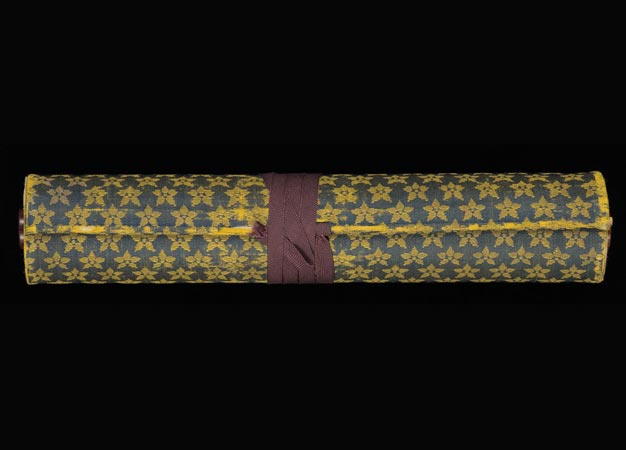A vast collection of rare books at Keio University is attracting worldwide interest through a new online course
Published online 23 June 2016

The single extant scroll-format copy of Shinsen Tsukuba shū (first volume) housed at Keio University's Shido Bunko (Institute of Oriental Classics).
© 2016 Keio University
Surrounded by floor-to-ceiling bookshelves filled with ancient scrolls, original manuscripts and rare artworks, Takahiro Sasaki, a professor at Keio University's Shido Bunko (Institute of Oriental Classics), reflects on his career. "When I studied medieval Japanese literature here at Keio University, I was struck by the sheer beauty of books. That was my first step into the world of bibliography," he says.
Housing 175,000 works, mainly Japanese classical texts, as well as pieces from China, Korea, and Vietnam, and a collection of rare Western books, Shido Bunko's library was amassed largely through items donated to the institute after World War II. Now, the world will have digital access to its collection through an online course guided by Sasaki. The course, Japanese Culture Through Rare Books, launched in collaboration with the UK's social learning platform FutureLearn and starting in July 2016, will explore the role of books in Japan's culture and history.
Books as time capsules
"Books are not just a way of preserving words and images," says Sasaki. "They are time capsules; their binding method, format and cover style can tell us a great deal about authorship and where they were made. We can learn about the cultural background, paper-making methods, fashions and technologies that led to their creation."
"For example, we have the single extant scroll-format copy of the first volume of Shinsen Tsukuba shū, written in the 15th century by imperial decree," says Sasaki of the anthology of Japanese collaborative poetry known as renga (see image). "Through research, I have found that the copyist of this work was not the master poet Sōboku as previously thought, but Anegakōji Mototsuna, a feudal lord who may have drafted the preliminary copy of the text."
Sasaki's detective work to unravel such mysteries using techniques such as handwriting analysis and comparative studies of textual lines is detailed in his book, The Bibliographical Study of Classical Japanese Texts, published in Japanese in June 2016. The book contains examples taken from popular works such as The Tale of Genji, The Tale of the Heike and The Pillow Book.
Opening up to the world
Unfurling a scroll dating back to 740 AD ― the oldest known in the university's collection ― Sasaki explains that Buddhist texts in the form of sutras came to Japan from China and Korea during the Nara period (710-794).
"Among all formats, including the 'multi-section-binding' and 'pouch-binding' styles used for classical texts, my research has shown that the scroll format symbolises the highest rank, meaning that the scroll is at the top of the cultural hierarchy in terms of both the content and readership," says Sasaki. The "multi-section-binding" format (tetsuyōsō) refers to single-folded pages sewn together along the fold and the "pouch-binding" style (fukuro-toji) refers to double-leaved pages forming a pouch as they are bound along the spine.
The scroll format subsequently influenced the placement of titles on bound books. For example, a vertical title on the left-hand side of a book cover often indicates that the book originated as a scroll, while a title placed in the center suggests that the book is a work of fiction, not derived from a scroll.
Japanese literature and the art of bookmaking flourished in the Heian (794-1185) and medieval (1185-1600) periods; this synergy of creativity is reflected in the diverse bookbinding techniques developed during this time and, for example, in the innovative use of minerals, such as mica powder to create luminous patterns.
"Today, we can see the influence of these features in Japanese stationery, which is famed for its intricate designs," says Sasaki. "Manga and anime also have their roots in these classical Japanese texts."
Sasaki observes that there is growing interest in Japanese rare books overseas. "We've had tremendous interest in our online course from around the world," he says. "I hope the course will deepen people's knowledge of Japanese culture and history," says Sasaki. "Books are an excellent gateway to understanding Japan."